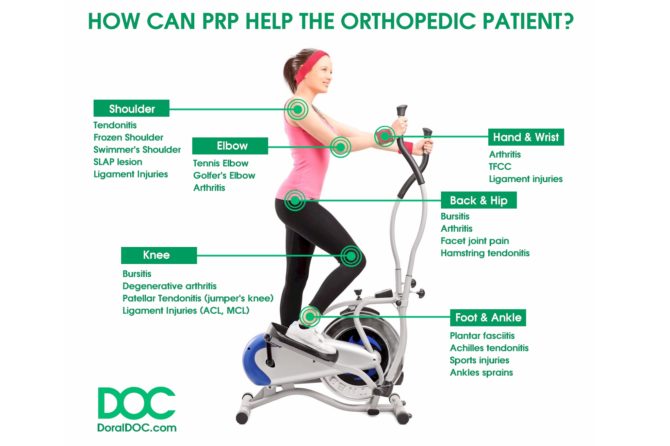
Platelet-rich plasma therapy, also known as PRP, has become popular among patients experiencing joint pain over the last ten years, especially given its success in treating tendinopathy and degenerative cellular diseases. The treatment was once reserved for professional athletes and yielded impressive results when used to assist in speeding up the recovery of sports injuries. Now, through advances in technology and in-office equipment, it is possible for the general population to receive PRP treatments.
Understanding platelet-rich plasma therapy and how it affects the body is important for the patient who has an injury, arthritis, or another condition that causes joint pain. In this post we look at how this therapy works, orthopedic conditions for which PRP is appropriate, and what to expect.
What is Platelet Rich Plasma therapy?
Platelet-rich plasma therapy is a treatment where a patient’s own blood is used to promote healing within their body. Blood is taken from the patient in the physician’s office, and then processed on-site via differential centrifugation, in order to create a concentrate that primarily consists of platelets in plasma. Preparation procedures are also relevant, as shown by studies of the chondro-inductive and osteoinductive potential of PRP. It is especially important to adhere to strict quality control methods in a clinical setting.
The guided PRP injections use each individual patient’s own healing system to improve musculoskeletal problems. Platelets, or thrombocytes, are rich in growth factors, which are compounds that promote healing and assist in the controlling of inflammation. These growth factors are also involved in the process of building new skin and tissue, as well as healing damaged tissue.
Does scientific evidence back-up the claims about PRP?
The use of platelet-rich plasma therapy has been extensively studied by scientists in order to determine how effective the treatment would be in the general population.
The Pilot and Feasibility Studies Journal holds a publication that provides evidence of the effectiveness that platelet-rich plasma offers when used in the treatment of knee arthritis. The pain was significantly reduced, and patient satisfaction was rated as highly positive.
A study in the Journal of Experimental and Therapeutic Medicine shows that platelet-rich plasma is highly effective at reducing inflammatory factors in patients with osteoarthritis. The same study suggests that this particular therapy could promote recovery in cartilage morphology. Thus, the destruction of cartilage caused by osteoarthritis may be stopped, and damaged joint tissue might be repaired with this use of this treatment.
A study in the Journal of Clinical Interventions in Aging also provided evidence that PRP treatment holds benefits for reducing pain score in patients with osteoarthritis. Another benefit noted by this study is an improvement in the function of the joint that is affected by this type of disease, leading to improved mobility and a reduction in the disability that often comes as a complication.
The number of PRP injections has also been shown to have an effect on the outcome of the treatment, with two injections found to improve outcomes significantly more than a singular injection.
What orthopedic conditions can be treated with PRP?
Shoulder
- Shoulder Arthritis
- Rotator cuff tendonitis
- Rotator cuff partial tears
- Ligament injuries
- Adhesive capsulitis (frozen shoulder)
- Impingement syndrome (swimmer’s shoulder)
- SLAP lesion
Elbow
- Elbow arthritis
- Lateral epicondylitis (tennis elbow)
- Medial Epicondylitis (golfer’s elbow)
Hand & Wrist
- Wrist arthritis
- Triangular fibrocartilage complex (TFCC)
- Ligament damage and sprains
Back & Hip
- Hip arthritis
- Hip bursitis
- Facet joint pain
- Hamstring tendonitis
Knee
- Bursitis
- Degenerative arthritis
- Patellar tendonitis (jumper’s knee)
- Ligament injuries (MCL, LCL, ACL, PCL)
Foot & Ankle
- Plantar fasciitis
- Achilles tendonitis
- Sports injuries
- Ankle sprains
How much does it cost?
The cost of the treatment varies according to the subspeciality and complexity of the injury and number of injections needed. Although most insurance plans, including Medicare, do NOT pay for PRP injections, your clinician may be able to help you find an appropriate payment plan.
Conclusion
The use of platelet-rich plasma therapy helps to improve the rate at which injuries heal, and may also be useful for reducing the effects that certain chronic conditions have on joints. The treatment is generally considered safe when administered by an orthopedic specialist in a clinical setting.
References
https://www.ncbi.nlm.nih.gov/pmc/articles/PMC6030745/
https://www.ncbi.nlm.nih.gov/pmc/articles/PMC5867452/
https://www.ncbi.nlm.nih.gov/pmc/articles/PMC5757490/
https://www.ncbi.nlm.nih.gov/pmc/articles/PMC6220011/
About the Doral Orthopedic Center
The Doral Orthopedic Center is a center of excellence, assembled to supply an exceptionally high concentration of expertise and related resources in orthopedic medicine. DOC physicians deliver associated care in a comprehensive, interdisciplinary fashion to afford the best patient outcomes possible.
Delivering enhanced healthcare experiences, the patient is emphasized above all other elements of operation.
Services on-site at 3560 NW 82nd Ave in Doral, Florida, include diagnosis and treatment by an esteemed team of South Florida’s leading orthopedic surgeons, an ambulatory surgery center, an urgent care center, physical therapy, MRI, digital x-ray, fluoroscopy, PRP and stem cell treatments. www.DoralDOC.com
Call DoralDOC at (305) 537-7272 to learn more or make an appointment today!



How interesting that PRP therapy reduces knee arthritis pain. This is something my mom should consider to treat her pain. Thanks for stating how beneficial PRP is.
ReplyIt’s cool that PRP therapy can help reduce pain. My thumb joint is pretty messed up, so I wonder if PRP could help me. Thanks so much for all the great information on PRP.
ReplyThat is interesting that platelet-rich plasma therapy can help those with joint pain. Maybe this is something I could try out for my knees. Soon I should talk to an orthopedic doctor about it.
ReplyMy aging father had been suffering from hip arthritis for the longest time now and probably have tried every option there is to alleviate the pain. It’s been getting worse these past few months and he wasn’t even able to endure long standing hours. What you’ve written had been really helpful to us since we weren’t fully aware of what plasma therapy could offer and how it could benefit my father. I also like the fact that you included studies to further strengthen your claim, and I love that you emphasized how the pain experienced by orthopedic patients got significantly reduced. We will consult a professional when can my father undergo this service and I hope it makes him feel better.
ReplyDoes it only work to reduce pain of arthritis in knee or it also cure it?
Reply